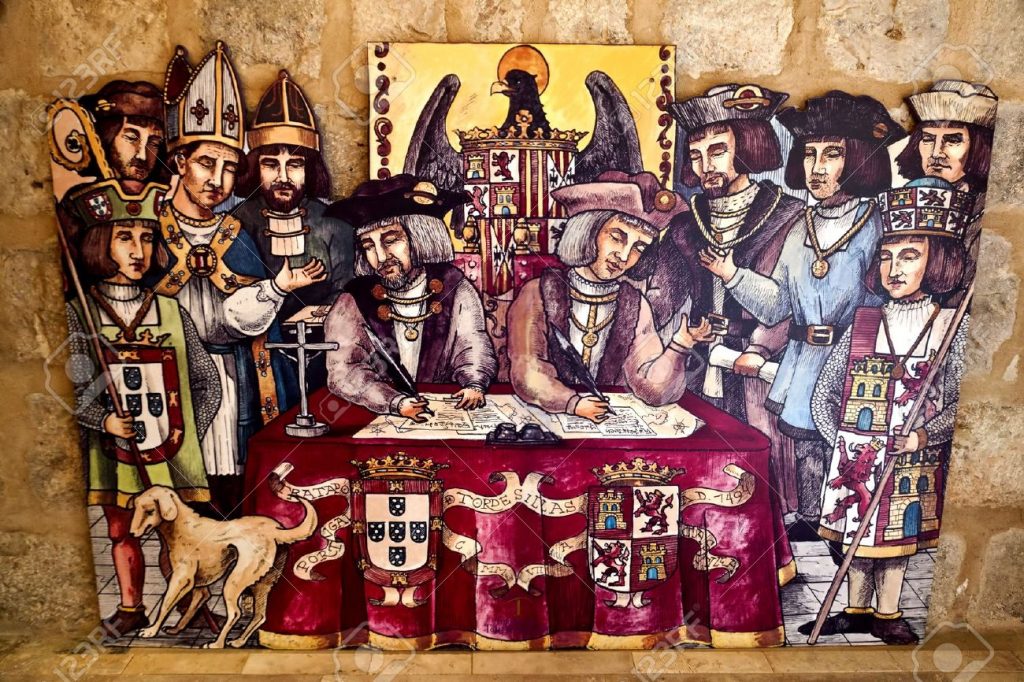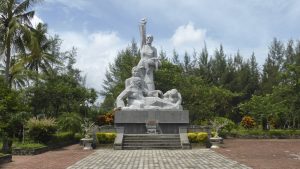The fifteenth century saw many changes for the nations of the “Old World.” It was the beginning of the age of exploration, and with that exploration came the exportation of their cultures, religion, and political power across vast, unexplored territories. What followed would be centuries of wars, treaties, and technological improvements that accelerated European dominance over Africa, the Americas, and parts of Asia. Two specific powers emerged during this early period as rivals: Portugal and Spain, with the latter eventually eclipsing the former through economic and political means. One event that helped propel Spain ahead of its competitor and gain numerous advantages was the treaty of Tordesillas.
The story, however, begins with Portugal taking the initial lead. In the early-fifteenth century, Portugal had begun to colonize several small islands in the Atlantic Ocean and some islands along the West African coast. It was not until 1488 that Bartolomeu Dias, appointed by King John II of Portugal, rounded the Cape of Good Hope and opened the way for Portuguese merchants to trade directly with India, and eventually with the East Indies.1 Spain also sought to establish trade with the East Indies, but only after a different route became possible subsequent to the voyages of Christopher Columbus.
Upon his arrival to the Americas, Columbus claimed all of the lands he visited for Spain. On his return, the Italian explorer stopped in Portugal and met with John II. After having learned of Columbus’ discoveries and the claims he had made for Spain, the Portuguese monarch grew upset and made his own claims to these lands. The king cited two pieces of writing as justification: the Treaty of Alcáçovas (1479) and the papal bull, Aeterni Regis (1481). These documents declared that Spain would control the surrounding area of the Canary Islands (near the coast of present-day Morocco) and Portugal would possess all of the lands to the west and south of this location.2 King John II believed that the lands discovered by Columbus were in the areas under Portuguese control as set forth by the 1479 treaty and the 1481 papal document. However, the Spanish monarchs, worried about their neighboring country’s claims, petitioned the leader of the Roman Catholic Church, Pope Alexander VI, to acknowledge their own claims to these lands.

The Supreme Pontiff Alexander VI (Roderic Borgia), a native of Aragon and personal friend of Ferdinand II, agreed with the Spanish monarchs and recognized their claims to these “new” territories.3 On May 4, 1493, in an effort to forestall future territorial disputes between Spain and Portugal, he issued a new papal bull, Inter Caetera Divinae, which formed an imaginary line running straight from the North and South poles. This line was located 100 leagues (345 miles) west of the Cape Verde Islands, which gave Spain control over all the territories west of this line, and Portugal gained control over those east of the line. The pope, however, specified that those lands already claimed by Christian sovereign powers would remain under their control.4
Spanish interests in the spice trade heavily influenced the position of the line since the monarchs believed the islands rich in spices were west of where Columbus had landed.5 If this had been the case, then Portugal would have effectively been excluded from trade with East Asia, giving all access to Spain. But Pope Alexander VI went even further with another papal bull, Dudum Siquidem, issued September 26, 1493, which gave Spain the right to claim lands discovered while traveling westward even if they fell in the Portuguese areas but had not yet been possessed by Portugal.6 John II was made furious by these bulls and threatened to send a fleet to Hispaniola to prevent the Spanish from colonizing those new areas. Thus, began new negotiations overseen by the same pope in 1494.

After much discussion and debate, the two Catholic powers agreed to place the imaginary line 370 leagues (1,277 miles) west of the Cape Verde Islands. Just like in Inter Caetera Divinae, Spain would possess all areas west of the line and Portugal all those east of the line. The treaty was ratified June 7, 1494 by both parties in the Castilian town of Tordesillas, and it was later recognized by Pope Julius II (successor of Alexander VI) in a papal bull in 1506.7 The treaty did have some flaws though, since it never clarified a standard for a league, (units of measure varied among the two countries), and it failed to mention which side of the Cape Verde Islands the measuring distance would start from.8 This led to a difficulty when establishing borders between the two colonial powers, because no one knew where the exact location of the line lay. The Treaty of Tordesillas was also rejected by England, France, and the Netherlands since the treaty excluded them from exploring the New World.9 As history later revealed, the treaty greatly benefited the Spanish monarchs and their economy. King Ferdinand II and Queen Isabella I gained vast amounts of colonial territory, which included colossal deposits of silver and gold. All of this eventually raised the prestige of Spain and made it the dominant power in Central and South America for centuries.
- Global Events: Milestone Events Throughout History, 2014, s.v. “Spain and Portugal Sign the Treaty of Tordesillas.” ↵
- Gale Encyclopedia of U.S. Economic History, 2000, s.v. “Tordesillas, Treaty of.” ↵
- Iberia and the Americas: Culture, Politics, and History, 2005, s.v. “Tordesillas, Treaty of (1494).” ↵
- Global Events: Milestone Events Throughout History, 2014, s.v. “Spain and Portugal Sign the Treaty of Tordesillas.” ↵
- Encyclopedia of Western Colonialism since 1450, 2007, s.v. “Treaty of Tordesillas,” by Alexander M. Zukas. ↵
- Iberia and the Americas: Culture, Politics, and History, 2005, s.v. “Tordesillas, Treaty of (1494).” ↵
- American Eras: Primary Sources, 2015, s.v. “Treaty of Tordesillas (Excerpt).” ↵
- Iberia and the Americas: Culture, Politics, and History, 2005, s.v. “Tordesillas, Treaty of (1494).” ↵
- American Eras: Primary Sources, 2015, s.v. “Treaty of Tordesillas (Excerpt).” ↵



56 comments
Hali Garcia
Great article. It is interesting learning about a fight for land. How it is determined who gets the land was something that I have always wondered. It is interesting how the Pope could determine where the line was and what the rules were. I have always wondered how it would be enforced also. Yes there were flaws, and I think those flaws were very important because it can have a major impact on the people who claim it. Overall, this is a very interesting and well written article, and I enjoyed reading it.
Danielle Slaughter
Very fascinating. I am descended from Spaniards myself, but I’m learning Portuguese, so I’m so torn! Joking aside, I do believe the Line of Demarcation was a good compromise — flawed, but good nonetheless. It is understandable that, especially in those mercantilistic days, both powers wanted all the land they could get. However, it must say something that although Spanish is spoken in more countries, Portuguese is spoken officially on almost every continent (barring North America). Both empires left an indelible impression in the world.
Sienna Guerra
Before reading this article, I knew that I have probably learned about the Treaty of Tordesillas but it was a fascinating article. I find it interesting how for example, how John II was upset of not discovering these new territories and how because of that, he decided to claim them. I also like that it included any lands not yet discovered in those areas.
Christopher Hohman
Nice article. I really love learning about colonialism. It is such a fascinating topic. It is funny to think of just how important Portugal was in the early days of colonialism. We usually think of them as such a small minor nation that we often forget that they were crucial in the early days of colonialism. I feel bad for them because they were just inherently not strong enough to compete with the Spanish. It also seems like they were treated unfairly by the mediators of these treaties
Regina De La Parra
This article, even though it is short, it teaches a lot about the early exploration and the era of colonialism. There are many interesting parts in this article. For example, how John II was upset of not discovering these new territories and how because of that, he decided to claim them. Or how to end any other discussion, the Pope drew imaginary lines to divide the territories between Spain and Portugal. Great research and article Sergio!
Tyler Sleeter
Great article. I am not very familiar with the Treaty of Tordesillas, and learned many things reading your article. It is interesting to me that the Pope could simply draw a line on a map and give everything to two countries without any consideration for England, France, or the Netherlands. I also like that it included any lands not yet discovered in those areas. I am not surprised that no consideration was given to the natives of these lands since that was an ongoing practice.
Maria Esquivel
I think the Treaty of Tordesillas is very interesting and very unfair, in my opinion. I knew the Pope drew an imaginary line, therefore, the west speaks Spanish and a small area from the east speaks Portuguese. I knew the focal points of the treaty but I also learned many new details. For instance how they measured in leagues and the papal bull, Dudum Siquidem. Very unfair! I also found the images very helpful.
Edgar Ramon
I speak Spanish thanks to an imaginary line haha. Although this treaty did not favor Portuguese expansion, there could be a case made for the Spanish receiving more land, even though they were not aware of how much land was to be found. The Portuguese had already begun spreading their influence in Asia, and to do that they needed men. The Spanish on the other hand, had a greater population, that could more easily hold these new territories, and populate them.
Natalia Flores
I did not know that one of the Borgias were a part of the Treaty of Tordesillas! That really blows my mind. It’s really unfair for Portugal (in my opinion) since they only got Brazil in the end. However, they didn’t know what was beyond that line so it was anyone’s guess back then. It’s quite interesting that they used different treaties to try to claim the Americas and how they struggled to create the Treaty of Tordesillas. This article painted this picture perfectly and really brought out the information as intended.
Fumei P.
I never realized that Spain and Portugal were such big rivals in the 1400’s exploration scene. I thought it was very clever of the Spanish monarchs to petition to Pope Alexander VI. Always helps to have friends in high places, especially the leader of the Roman Catholic Church, who can just issue new papal bulls to aid you on your conquests for new lands and spices.